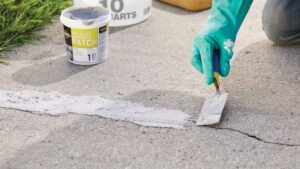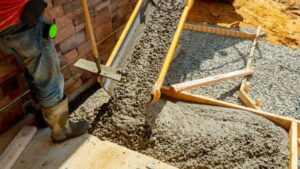As the demand for environmentally friendly construction materials grows, sustainable alternatives to traditional concrete are gaining traction in the industry. Traditional concrete, while durable and widely used, has a high carbon footprint due to its energy-intensive production process. Fortunately, new and innovative materials are emerging that offer similar strength and durability without the environmental drawbacks.
These alternatives reduce greenhouse gas emissions, conserve natural resources, and promote a circular economy by reusing waste products. Whether you’re working on a large-scale construction project or a simple home renovation, exploring sustainable materials can make a significant impact on reducing the overall environmental burden. From hempcrete to recycled plastic, there are numerous eco-friendly options to consider. In this blog, we’ll explore 10 of the most promising sustainable alternatives to traditional concrete, helping you make more informed, green choices for your next project.
10 Sustainable Alternatives To Traditional Concrete
1. Hempcrete
A lime-based binder is combined with the inner, woody core of the hemp plant to create hempcrete, a bio-composite material. This sustainable alternative to concrete is lightweight, highly insulating, and carbon-negative. Hemp plants absorb large amounts of CO2 during their growth, which is stored in the final product.
This makes hempcrete an excellent option for reducing the overall carbon footprint of a building project. Additionally, hempcrete offers excellent thermal and acoustic insulation, making it ideal for homes in both hot and cold climates. While not as strong as traditional concrete, hempcrete is often used as infill material in timber-framed structures, contributing to sustainability without sacrificing durability.
Another major benefit of hempcrete is its breathability, allowing moisture to pass through, which helps to regulate humidity and prevent mold growth. The material is also non-toxic, recyclable, and resistant to pests, making it a healthier option for indoor environments. Though it is still relatively new in mainstream construction, hempcrete is rapidly gaining popularity due to its eco-friendly benefits.
Also Read:- Steps To Pour a Perfect Concrete Slab
2. Bamboo
Bamboo has been used as a construction material for centuries, particularly in regions where the plant is abundant. It is an incredibly fast-growing, renewable resource that can be harvested sustainably without damaging the environment. Bamboo has a high tensile strength, making it comparable to steel when used as a structural material. Its lightweight yet durable properties make it an attractive alternative to traditional concrete, especially in earthquake-prone areas where flexibility is essential.
In addition to its strength, bamboo is an environmentally friendly choice because it absorbs large amounts of carbon dioxide and requires minimal water to grow. It can also be harvested within 3-5 years, much faster than the time it takes to grow trees for wood-based construction. Bamboo can be used in a variety of applications, from structural beams and flooring to scaffolding and fencing. It also contributes to aesthetic appeal due to its natural beauty, making it a versatile choice for sustainable construction.
3. Recycled Plastic
Recycled plastic concrete is an innovative solution to the growing problem of plastic waste. By using plastic waste as an aggregate or binder in concrete mixtures, builders can significantly reduce the amount of new materials needed. This approach not only helps to repurpose waste materials but also reduces the demand for traditional cement, which is known for its high carbon emissions. Recycled plastic concrete is lightweight, durable, and resistant to corrosion, making it suitable for a range of construction applications.
One of the main advantages of using recycled plastic in concrete is its environmental benefits. By diverting plastic from landfills and oceans, this material helps combat pollution while providing a practical solution for construction. Furthermore, plastic-based concrete is easier to transport due to its reduced weight, resulting in lower transportation-related emissions. While still in the development stages, recycled plastic concrete holds significant promise as a sustainable alternative to traditional materials, particularly for non-load-bearing applications.
4. Ashcrete
Ashcrete is a sustainable building material made by replacing cement with fly ash, a byproduct of coal combustion. Fly ash is often discarded in landfills, but when used as a component in concrete, it creates a material that is not only strong but also environmentally friendly. Ashcrete reduces the need for cement, lowering the carbon emissions associated with traditional concrete production. This alternative also utilizes industrial waste that would otherwise contribute to environmental degradation.
The use of ashcrete can significantly reduce the environmental impact of construction projects. It offers similar strength and durability to traditional concrete while being more resistant to cracking and shrinkage. Additionally, the material is less permeable, making it a suitable choice for applications requiring water resistance, such as foundations and pavements. By repurposing fly ash, ashcrete promotes a circular economy, minimizing waste and contributing to sustainable construction practices.
5. Ferrock
Ferrock is a carbon-negative building material made from recycled materials, including steel dust and silica, which would otherwise be considered waste. What makes ferrock particularly unique is its ability to absorb CO2 during the curing process, which makes it even more environmentally friendly than concrete. This alternative material is not only strong but also more flexible than traditional concrete, making it less prone to cracking under pressure or seismic activity.
Ferrock has shown promise in a variety of applications, including as a substitute for traditional concrete in buildings, roads, and marine structures. Its resistance to corrosion makes it especially well-suited for projects exposed to water or salt, such as coastal infrastructure. The material’s ability to absorb carbon dioxide means that using ferrock can help offset the carbon emissions of a construction project, making it a powerful tool in the fight against climate change.
6. Mycelium
Mycelium, the root structure of fungi, is an organic material that has recently gained attention as a sustainable building alternative. When combined with agricultural waste, mycelium forms a solid, lightweight structure that can be molded into various shapes. Mycelium-based materials are fully biodegradable and have the potential to replace conventional building materials in certain applications. While not suitable for load-bearing structures, mycelium can be used for insulation, interior walls, and furniture.
Mycelium grows quickly and requires very little energy or water to cultivate, making it an eco-friendly alternative to materials that require more resources to produce. The material is also fire-resistant, insulating, and highly versatile in terms of its form. As a bio-based material, mycelium can be fully composted at the end of its life cycle, contributing to a circular construction economy and minimizing waste.
7. Straw Bale
Straw bale construction has been around for centuries, and it’s making a comeback as an eco-friendly alternative to traditional building materials. Straw, an agricultural byproduct, is highly renewable and biodegradable, making it an excellent choice for sustainable construction. Straw bales are typically used to create highly insulated walls that can reduce energy consumption in homes. With proper sealing, they are fire-resistant, and their thick structure provides excellent soundproofing.
Straw bale construction is not only affordable but also promotes sustainability by utilizing a waste product that would otherwise be discarded. The natural insulation provided by straw bales reduces the need for additional energy sources to heat or cool a building, contributing to long-term energy savings. While it may not replace concrete for every application, straw bale is a viable option for homes and smaller structures focused on sustainability.
8. Rammed Earth
Rammed earth is an ancient building technique that involves compressing layers of damp earth into a mold to create solid walls. This method is highly sustainable, as it uses natural materials that are readily available and require minimal processing. Rammed earth structures have excellent thermal mass, which helps regulate indoor temperatures by absorbing heat during the day and releasing it at night. This reduces the need for artificial heating and cooling, lowering energy consumption.
Rammed earth is not only eco-friendly but also incredibly durable. Some rammed earth structures have lasted for centuries, proving the material’s resilience. The natural aesthetics of rammed earth also make it an attractive option for modern architecture. While it requires specialized labor to construct, rammed earth is gaining popularity in sustainable building practices due to its low environmental impact and energy efficiency.
9. Green Concrete
Green concrete is a broad term for concrete that incorporates waste materials or alternative ingredients to reduce its environmental footprint. This can include using industrial byproducts like slag, fly ash, or recycled aggregates to replace traditional materials. Green concrete reduces the need for virgin materials, conserves natural resources, and lowers the overall carbon emissions associated with production. In some cases, it can even improve the performance of the concrete by increasing its strength and durability.
One of the key benefits of green concrete is its adaptability. It can be customized for different types of construction projects, making it a versatile solution for builders looking to reduce their environmental impact. Additionally, green concrete often performs better in terms of resistance to environmental conditions, making it a durable and long-lasting alternative to traditional concrete. As the demand for sustainable materials grows, green concrete is likely to become a staple in the construction industry.
Also Read:- Tools You Need For Concrete Work
10. Geopolymer Concrete
Geopolymer concrete is an innovative alternative to traditional concrete that uses inorganic materials such as fly ash, slag, or clay to form the binding agent. This type of concrete is highly sustainable because it reduces the need for Portland cement, which is responsible for a large portion of the construction industry’s carbon emissions. Geopolymer concrete also has superior durability and resistance to harsh environmental conditions, making it suitable for long-lasting structures.
One of the standout features of geopolymer concrete is its ability to withstand extreme temperatures and chemical exposure, which makes it ideal for industrial and infrastructure projects. Additionally, the production of geopolymer concrete generates less CO2 and consumes less energy than conventional concrete, contributing to a greener construction process. As the technology continues to evolve, geopolymer concrete is becoming a promising option for eco-friendly construction on a large scale.
Conclusion
Transitioning to sustainable construction materials like the alternatives mentioned can greatly reduce the environmental impact of your projects. By choosing eco-friendly options such as hempcrete, bamboo, and recycled plastic, you’re contributing to the reduction of carbon emissions and resource depletion.
As green building practices continue to evolve, these materials offer a pathway toward more sustainable development. Embracing innovative solutions not only benefits the planet but also enhances the longevity and efficiency of your structures. Explore these options further to build a more sustainable future.
FAQs
What are some sustainable alternatives to traditional concrete?
Some sustainable alternatives include hempcrete, bamboo, recycled plastic, ashcrete, and ferrock, all of which offer eco-friendly properties and reduce carbon emissions.
Why is traditional concrete considered environmentally harmful?
Traditional concrete has a high carbon footprint due to the energy-intensive process required to produce cement, a key ingredient, which contributes significantly to global CO2 emissions.




